Flink-1.19.0源码详解8-ExecutionGraph生成-前篇
Flink是Apache软件基金会下开源的分布式流批一体计算框架,具备实时流计算和高吞吐批处理计算的大数据计算能力。本专栏内容为Flink源码解析的记录与分享。
本文解析的Kafka源码版本为:flink-1.19.0
1.ExecutionGraph生成功能概述
在前文《Flink-1.19.0源码详解5-JobGraph生成-前篇》和《Flink-1.19.0源码详解6-JobGraph生成-后篇》中,已介绍了Flink JobGraph生成的源码,解析Flink遍历StreamGraph的每个StreamNode节点,逐步生成JobVertex节点、JobEdge边和IntermediateDataSet数据集,构建JobGraph图的过程。在完成 JobGraph的生成后,Flink Client会向Yarn中的Flink集群提交调度请求与JobGraph图,完成把调度从客户端进行到集群端的转变。
本文从Flink集群端调度开始解析ExecutionGraph生成源码(内容为下流程图的红色部分),解析了Flink JobMaster对JobVertex节点进行遍历,依次生成ExecutionJobVertex节点、ExecutionVertex节点、IntermediateResult数据集、IntermediateResultPartition数据集分区和其连接关系,解析了构建ExecutionGraph图的完整源码。

ExecutionGraph生成的本质是在原本逻辑数据处理流图JobGraph的基础上,按并行度做分布式展开,生成分布式数据处理流图ExecutionGraph。

Flink的ExecutionGraph生成主要是通过遍历JobGraph中每个JobVertex节点,生成其对应的ExecutionJobVertex节点,并为每个JobVertex节点的IntermediateDataSet数据集生成IntermediateResult数据集。ExecutionGraph进一步把原有的JobGraph进行分布式并行化展开,把ExecutionJobVertex节点按并行度创建ExecutionVertex节点和封装其执行信息的Execution,把IntermediateResult数据集按并行度创建IntermediateResultPartition数据集分区,并创建边连接上下游IntermediateResultPartition数据集分区与ExecutionVertex节点。

ExecutionGraph生成的具体步骤如下:
1.创建ExecutionJobVertex:遍历JobGraph的JobVertex,为每个JobVertex创建对应的ExecutionJobVertex。
2.创建IntermediateResul:获取ExecutionJobVertex对应JobVertex下游的IntermediateDataSet,为每个IntermediateDataSet创建对应的IntermediateResult。
3.创建ExecutionVertex:按并行度为每个ExecutionJobVertex创建ExecutionVertex。
4.创建Execution:为每个并行度上的ExecutionVertex创建封装其执行信息的Execution。
5.创建IntermediateResultPartition:创建每个ExecutionVertex上每个IntermediateResult的IntermediateResultPartition。
6.创建边:Flink在新版本(1.13后)取消了ExecutionEdge,用EdgeManager管理的(Map<ExecutionVertexID, List<ConsumedPartitionGroup>>和Map<IntermediateResultPartitionID, List<ConsumerVertexGroup>>来保存IntermediateResultPartition与ExecutionVertex的连接关系。
7.最终创建完整的ExecutionGraph:最终完成对所有的JobVertex的遍历,依次生成ExecutionJobVertex、ExecutionVertex、IntermediateResult、IntermediateResultPartition和其连接关系,构建完整的ExecutionGraph图。
ExecutionGraph生成源码图解:

完整代码解析:

2.进入ExecutionGraph调度
在创建JobMaster时,JobMaster会在创建SchedulerNG实例时,调用DefaultExecutionGraphBuilder的buildGraph()方法,开始进行ExecutionGraph的生成。
源码图解:
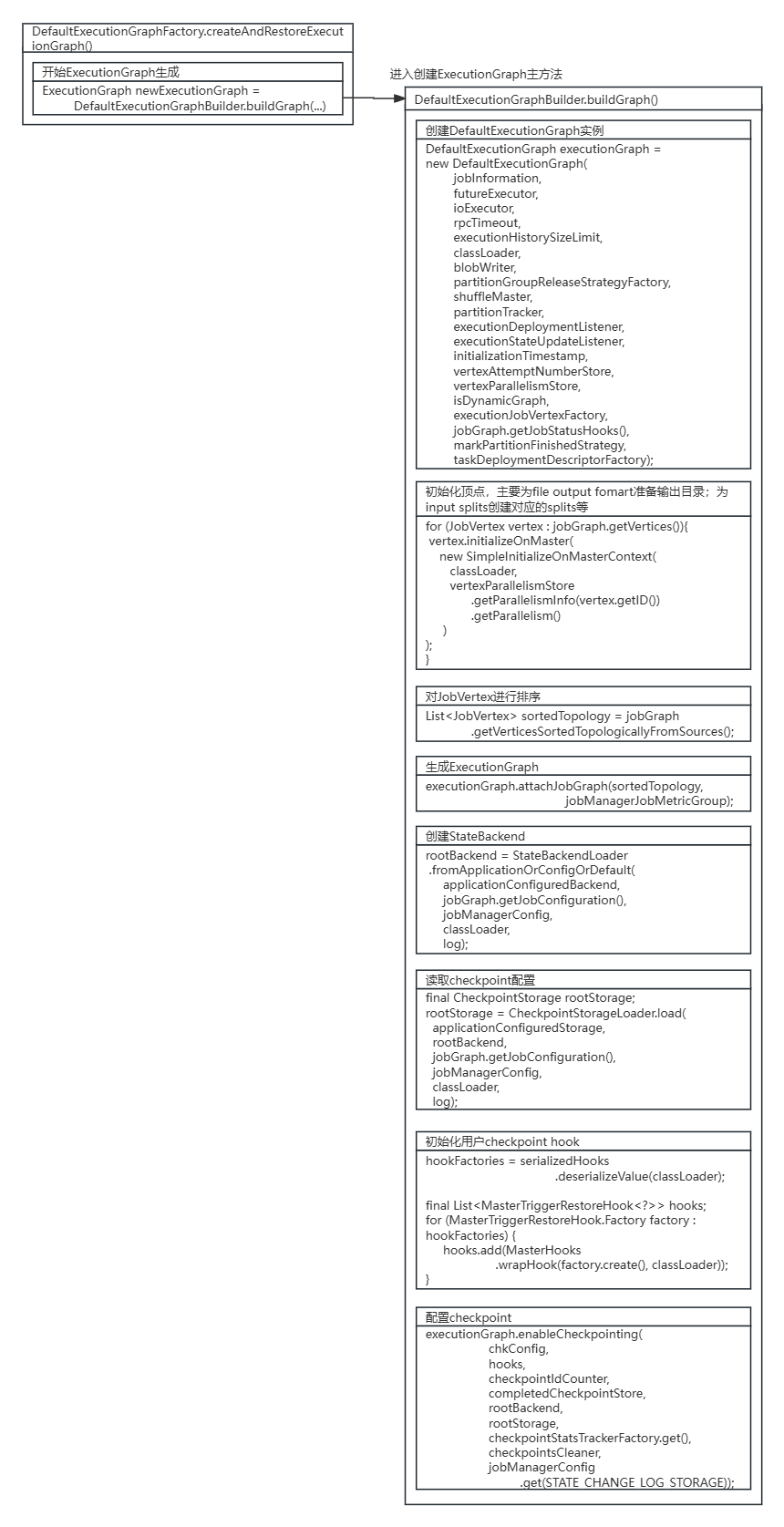
DefaultExecutionGraphBuilder.buildGraph()方法创建了ExecutionGraph实例、初始化了JobVertex节点并对其进行了排序,配置了StateBackend和Checkpoint。其中关键是调用ExecutionGraph的attachJobGraph()方法,开始了ExecutionGraph图节点与边的生成。
DefaultExecutionGraphBuilder.buildGraph()方法源码:
public static DefaultExecutionGraph buildGraph(JobGraph jobGraph,Configuration jobManagerConfig,ScheduledExecutorService futureExecutor,Executor ioExecutor,ClassLoader classLoader,CompletedCheckpointStore completedCheckpointStore,CheckpointsCleaner checkpointsCleaner,CheckpointIDCounter checkpointIdCounter,Time rpcTimeout,BlobWriter blobWriter,Logger log,ShuffleMaster<?> shuffleMaster,JobMasterPartitionTracker partitionTracker,TaskDeploymentDescriptorFactory.PartitionLocationConstraint partitionLocationConstraint,ExecutionDeploymentListener executionDeploymentListener,ExecutionStateUpdateListener executionStateUpdateListener,long initializationTimestamp,VertexAttemptNumberStore vertexAttemptNumberStore,VertexParallelismStore vertexParallelismStore,Supplier<CheckpointStatsTracker> checkpointStatsTrackerFactory,boolean isDynamicGraph,ExecutionJobVertex.Factory executionJobVertexFactory,MarkPartitionFinishedStrategy markPartitionFinishedStrategy,boolean nonFinishedHybridPartitionShouldBeUnknown,JobManagerJobMetricGroup jobManagerJobMetricGroup)throws JobExecutionException, JobException {checkNotNull(jobGraph, "job graph cannot be null");final String jobName = jobGraph.getName();final JobID jobId = jobGraph.getJobID();final JobInformation jobInformation =new JobInformation(jobId,jobName,jobGraph.getSerializedExecutionConfig(),jobGraph.getJobConfiguration(),jobGraph.getUserJarBlobKeys(),jobGraph.getClasspaths());final int executionHistorySizeLimit =jobManagerConfig.get(JobManagerOptions.MAX_ATTEMPTS_HISTORY_SIZE);final PartitionGroupReleaseStrategy.Factory partitionGroupReleaseStrategyFactory =PartitionGroupReleaseStrategyFactoryLoader.loadPartitionGroupReleaseStrategyFactory(jobManagerConfig);final int offloadShuffleDescriptorsThreshold =jobManagerConfig.get(TaskDeploymentDescriptorFactory.OFFLOAD_SHUFFLE_DESCRIPTORS_THRESHOLD);final TaskDeploymentDescriptorFactory taskDeploymentDescriptorFactory;try {taskDeploymentDescriptorFactory =new TaskDeploymentDescriptorFactory(BlobWriter.serializeAndTryOffload(jobInformation, jobId, blobWriter),jobId,partitionLocationConstraint,blobWriter,nonFinishedHybridPartitionShouldBeUnknown,offloadShuffleDescriptorsThreshold);} catch (IOException e) {throw new JobException("Could not create the TaskDeploymentDescriptorFactory.", e);}//创建DefaultExecutionGraph实例// create a new execution graph, if none exists so farfinal DefaultExecutionGraph executionGraph =new DefaultExecutionGraph(jobInformation,futureExecutor,ioExecutor,rpcTimeout,executionHistorySizeLimit,classLoader,blobWriter,partitionGroupReleaseStrategyFactory,shuffleMaster,partitionTracker,executionDeploymentListener,executionStateUpdateListener,initializationTimestamp,vertexAttemptNumberStore,vertexParallelismStore,isDynamicGraph,executionJobVertexFactory,jobGraph.getJobStatusHooks(),markPartitionFinishedStrategy,taskDeploymentDescriptorFactory);// set the basic propertiestry {executionGraph.setJsonPlan(JsonPlanGenerator.generatePlan(jobGraph));} catch (Throwable t) {log.warn("Cannot create JSON plan for job", t);// give the graph an empty planexecutionGraph.setJsonPlan("{}");}// initialize the vertices that have a master initialization hook// file output formats create directories here, input formats create splitsfinal long initMasterStart = System.nanoTime();log.info("Running initialization on master for job {} ({}).", jobName, jobId);//初始化顶点,主要为file output fomart准备输出目录;为input splits创建对应的splits等for (JobVertex vertex : jobGraph.getVertices()) {String executableClass = vertex.getInvokableClassName();if (executableClass == null || executableClass.isEmpty()) {throw new JobSubmissionException(jobId,"The vertex "+ vertex.getID()+ " ("+ vertex.getName()+ ") has no invokable class.");}try {vertex.initializeOnMaster(new SimpleInitializeOnMasterContext(classLoader,vertexParallelismStore.getParallelismInfo(vertex.getID()).getParallelism()));} catch (Throwable t) {throw new JobExecutionException(jobId,"Cannot initialize task '" + vertex.getName() + "': " + t.getMessage(),t);}}log.info("Successfully ran initialization on master in {} ms.",(System.nanoTime() - initMasterStart) / 1_000_000);//对JobVertex进行排序// topologically sort the job vertices and attach the graph to the existing oneList<JobVertex> sortedTopology = jobGraph.getVerticesSortedTopologicallyFromSources();if (log.isDebugEnabled()) {log.debug("Adding {} vertices from job graph {} ({}).",sortedTopology.size(),jobName,jobId);}//生成ExecutionGraphexecutionGraph.attachJobGraph(sortedTopology, jobManagerJobMetricGroup);if (log.isDebugEnabled()) {log.debug("Successfully created execution graph from job graph {} ({}).", jobName, jobId);}// configure the state checkpointingif (isDynamicGraph) {// dynamic graph does not support checkpointing so we skip itlog.warn("Skip setting up checkpointing for a job with dynamic graph.");} else if (isCheckpointingEnabled(jobGraph)) {JobCheckpointingSettings snapshotSettings = jobGraph.getCheckpointingSettings();// load the state backend from the application settingsfinal StateBackend applicationConfiguredBackend;final SerializedValue<StateBackend> serializedAppConfigured =snapshotSettings.getDefaultStateBackend();if (serializedAppConfigured == null) {applicationConfiguredBackend = null;} else {try {applicationConfiguredBackend =serializedAppConfigured.deserializeValue(classLoader);} catch (IOException | ClassNotFoundException e) {throw new JobExecutionException(jobId, "Could not deserialize application-defined state backend.", e);}}//创建StateBackendfinal StateBackend rootBackend;try {rootBackend =StateBackendLoader.fromApplicationOrConfigOrDefault(applicationConfiguredBackend,jobGraph.getJobConfiguration(),jobManagerConfig,classLoader,log);} catch (IllegalConfigurationException | IOException | DynamicCodeLoadingException e) {throw new JobExecutionException(jobId, "Could not instantiate configured state backend", e);}// load the checkpoint storage from the application settingsfinal CheckpointStorage applicationConfiguredStorage;final SerializedValue<CheckpointStorage> serializedAppConfiguredStorage =snapshotSettings.getDefaultCheckpointStorage();if (serializedAppConfiguredStorage == null) {applicationConfiguredStorage = null;} else {try {applicationConfiguredStorage =serializedAppConfiguredStorage.deserializeValue(classLoader);} catch (IOException | ClassNotFoundException e) {throw new JobExecutionException(jobId,"Could not deserialize application-defined checkpoint storage.",e);}}//读取checkpoint配置final CheckpointStorage rootStorage;try {rootStorage =CheckpointStorageLoader.load(applicationConfiguredStorage,rootBackend,jobGraph.getJobConfiguration(),jobManagerConfig,classLoader,log);} catch (IllegalConfigurationException | DynamicCodeLoadingException e) {throw new JobExecutionException(jobId, "Could not instantiate configured checkpoint storage", e);}// instantiate the user-defined checkpoint hooksfinal SerializedValue<MasterTriggerRestoreHook.Factory[]> serializedHooks =snapshotSettings.getMasterHooks();final List<MasterTriggerRestoreHook<?>> hooks;//初始化用户checkpoint hookif (serializedHooks == null) {hooks = Collections.emptyList();} else {final MasterTriggerRestoreHook.Factory[] hookFactories;try {hookFactories = serializedHooks.deserializeValue(classLoader);} catch (IOException | ClassNotFoundException e) {throw new JobExecutionException(jobId, "Could not instantiate user-defined checkpoint hooks", e);}final Thread thread = Thread.currentThread();final ClassLoader originalClassLoader = thread.getContextClassLoader();thread.setContextClassLoader(classLoader);try {hooks = new ArrayList<>(hookFactories.length);for (MasterTriggerRestoreHook.Factory factory : hookFactories) {hooks.add(MasterHooks.wrapHook(factory.create(), classLoader));}} finally {thread.setContextClassLoader(originalClassLoader);}}final CheckpointCoordinatorConfiguration chkConfig =snapshotSettings.getCheckpointCoordinatorConfiguration();//配置CheckpointexecutionGraph.enableCheckpointing(chkConfig,hooks,checkpointIdCounter,completedCheckpointStore,rootBackend,rootStorage,checkpointStatsTrackerFactory.get(),checkpointsCleaner,jobManagerConfig.get(STATE_CHANGE_LOG_STORAGE));}return executionGraph;
}在DefaultExecutionGraph的attachJobGraph()方法中,进行了ExecutionJobVertex节点的生成与初始化,并把ExecutionGraph划分了SchedulingPipelinedRegion。
DefaultExecutionGraph.attachJobGraph()方法源码:
public void attachJobGraph(List<JobVertex> verticesToAttach, JobManagerJobMetricGroup jobManagerJobMetricGroup)throws JobException {assertRunningInJobMasterMainThread();LOG.debug("Attaching {} topologically sorted vertices to existing job graph with {} "+ "vertices and {} intermediate results.",verticesToAttach.size(),tasks.size(),intermediateResults.size());//生成ExecutionJobVertexattachJobVertices(verticesToAttach, jobManagerJobMetricGroup);if (!isDynamic) {//初始化所有ExecutionJobVertexinitializeJobVertices(verticesToAttach);}//将ExecutionGraph的拓扑划分Region// the topology assigning should happen before notifying new vertices to failoverStrategyexecutionTopology = DefaultExecutionTopology.fromExecutionGraph(this);partitionGroupReleaseStrategy =partitionGroupReleaseStrategyFactory.createInstance(getSchedulingTopology());
}3.创建ExecutionJobVertex
在DefaultExecutionGraph的attachJobGraph()方法中,调用了DefaultExecutionGraph的attachJobVertices()方法进行ExecutionJobVertex节点的生成。

源码图解:

DefaultExecutionGraph的attachJobVertices()方法遍历了JobGraph中所有的JobVertex节点,为每个JobVertex节点生成对应的ExecutionJobVertex节点。
DefaultExecutionGraph.attachJobVertices()方法源码:
private void attachJobVertices(List<JobVertex> topologicallySorted, JobManagerJobMetricGroup jobManagerJobMetricGroup)throws JobException {//遍历所有JobVertexfor (JobVertex jobVertex : topologicallySorted) {//...//遍历JobGraph的所有JobVertex,生成ExecutionJobVertex// create the execution job vertex and attach it to the graphExecutionJobVertex ejv =executionJobVertexFactory.createExecutionJobVertex(this,jobVertex,parallelismInfo,coordinatorStore,jobManagerJobMetricGroup);//...}
}其中调用的ExecutionJobVertex.Factory.createExecutionJobVertex()方法具体创建了ExecutionJobVertex实例。
ExecutionJobVertex.Factory.createExecutionJobVertex()方法源码:
public static class Factory {ExecutionJobVertex createExecutionJobVertex(InternalExecutionGraphAccessor graph,JobVertex jobVertex,VertexParallelismInformation parallelismInfo,CoordinatorStore coordinatorStore,JobManagerJobMetricGroup jobManagerJobMetricGroup)throws JobException {//创建ExecutionJobVertex实例return new ExecutionJobVertex(graph, jobVertex, parallelismInfo, coordinatorStore, jobManagerJobMetricGroup);
}4.进入ExecutionJobVertex初始化
完成了ExecutionJobVertex节点创建后,还需要对ExecutionJobVertex节点对应的ExecutionVertex节点与IntermediateResult数据集进行创建。

在DefaultExecutionGraph的attachJobGraph()方法中,在执行完DefaultExecutionGraph的attachJobVertices()方法创建完ExecutionJobVertex节点后,会继续执行DefaultExecutionGraph的initializeJobVertices()方法开始初始化ExecutionJobVertex节点。
源码图解:
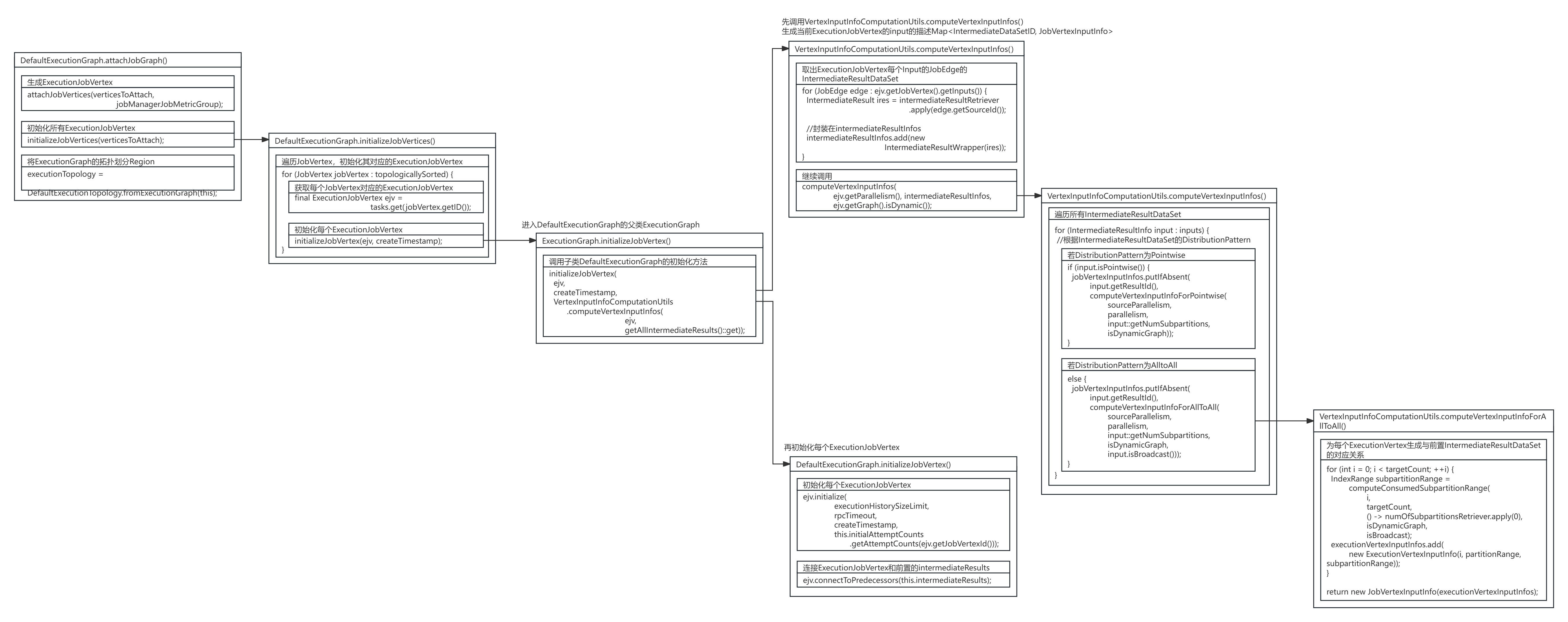
DefaultExecutionGraph.attachJobGraph()方法源码:
public void attachJobGraph(List<JobVertex> verticesToAttach, JobManagerJobMetricGroup jobManagerJobMetricGroup)throws JobException {assertRunningInJobMasterMainThread();LOG.debug("Attaching {} topologically sorted vertices to existing job graph with {} "+ "vertices and {} intermediate results.",verticesToAttach.size(),tasks.size(),intermediateResults.size());//生成ExecutionJobVertexattachJobVertices(verticesToAttach, jobManagerJobMetricGroup);if (!isDynamic) {//初始化所有ExecutionJobVertexinitializeJobVertices(verticesToAttach);}//将ExecutionGraph的拓扑划分Region// the topology assigning should happen before notifying new vertices to failoverStrategyexecutionTopology = DefaultExecutionTopology.fromExecutionGraph(this);partitionGroupReleaseStrategy =partitionGroupReleaseStrategyFactory.createInstance(getSchedulingTopology());
}DefaultExecutionGraph.initializeJobVertices()方法遍历了JobGraph中所有JobVertex节点,找到每个JobVertex节点对应的ExecutionJobVertex节点,并对其进行初始化。
DefaultExecutionGraph.initializeJobVertices()方法源码:
private void initializeJobVertices(List<JobVertex> topologicallySorted) throws JobException {final long createTimestamp = System.currentTimeMillis();//遍历JobVertex,初始化其对应的ExecutionJobVertexfor (JobVertex jobVertex : topologicallySorted) {//获取每个JobVertex对应的ExecutionJobVertexfinal ExecutionJobVertex ejv = tasks.get(jobVertex.getID());//初始化每个ExecutionJobVertexinitializeJobVertex(ejv, createTimestamp);}
}DefaultExecutionGraph的initializeJobVertex()方法继承自其父类ExecutionGraph,在ExecutionGraph.initializeJobVertex()方法中,先调用VertexInputInfoComputationUtils的computeVertexInputInfos()方法生成当前ExecutionJobVertex节点的每个输入描述Map<IntermediateDataSetID, JobVertexInputInfo>,再初始化每个ExecutionJobVertex节点。
ExecutionGraph.initializeJobVertex()方法源码:
default void initializeJobVertex(ExecutionJobVertex ejv, long createTimestamp)throws JobException {//2.再初始化每个ExecutionJobVertexinitializeJobVertex(ejv,createTimestamp,//1.先调用VertexInputInfoComputationUtils.computeVertexInputInfos()生成当前ExecutionJobVertex的input的描述Map<IntermediateDataSetID, JobVertexInputInfo>VertexInputInfoComputationUtils.computeVertexInputInfos(ejv, getAllIntermediateResults()::get));
}VertexInputInfoComputationUtils的computeVertexInputInfos()方法取出ExecutionJobVertex节点每个输入JobEdge的IntermediateResultDataSet数据集,并继续调用VertexInputInfoComputationUtils的computeVertexInputInfos()方法。
VertexInputInfoComputationUtils.computeVertexInputInfos()方法源码:
public static Map<IntermediateDataSetID, JobVertexInputInfo> computeVertexInputInfos(ExecutionJobVertex ejv,Function<IntermediateDataSetID, IntermediateResult> intermediateResultRetriever)throws JobException {checkState(ejv.isParallelismDecided());final List<IntermediateResultInfo> intermediateResultInfos = new ArrayList<>();//取出ExecutionJobVertex每个Input的JobEdge的IntermediateResultDataSetfor (JobEdge edge : ejv.getJobVertex().getInputs()) {IntermediateResult ires = intermediateResultRetriever.apply(edge.getSourceId());if (ires == null) {throw new JobException("Cannot connect this job graph to the previous graph. No previous intermediate result found for ID "+ edge.getSourceId());}intermediateResultInfos.add(new IntermediateResultWrapper(ires));}//继续调用computeVertexInputInfos()方法return computeVertexInputInfos(ejv.getParallelism(), intermediateResultInfos, ejv.getGraph().isDynamic());
}VertexInputInfoComputationUtils的computeVertexInputInfos()方法遍历ExecutionJobVertex节点上游JobEdge中的每个IntermediateResultDataSet,根据DistributionPattern为Pointwise或AlltoAll生成不同的节点输入描述JobVertexInputInfo。
VertexInputInfoComputationUtils.computeVertexInputInfos()方法源码:
public static Map<IntermediateDataSetID, JobVertexInputInfo> computeVertexInputInfos(int parallelism,List<? extends IntermediateResultInfo> inputs,boolean isDynamicGraph) {checkArgument(parallelism > 0);final Map<IntermediateDataSetID, JobVertexInputInfo> jobVertexInputInfos =new LinkedHashMap<>();//遍历所有IntermediateResultDataSetfor (IntermediateResultInfo input : inputs) {//根据IntermediateResultDataSet的DistributionPatternint sourceParallelism = input.getNumPartitions();若DistributionPattern为Pointwiseif (input.isPointwise()) {jobVertexInputInfos.putIfAbsent(input.getResultId(),computeVertexInputInfoForPointwise(sourceParallelism,parallelism,input::getNumSubpartitions,isDynamicGraph));} else {//若DistributionPattern为AlltoAlljobVertexInputInfos.putIfAbsent(input.getResultId(),computeVertexInputInfoForAllToAll(sourceParallelism,parallelism,input::getNumSubpartitions,isDynamicGraph,input.isBroadcast()));}}return jobVertexInputInfos;
}为每个ExecutionVerte节点生成对应的输入描述JobVertexInputInfo,需根据不同的DistributionPattern连接类型生成,若DistributionPattern为Pointwise,根据索引比例滑动选择分区为每个ExecutionJobVertex安排JobVertexInputInfo,若DistributionPattern为AlltoAll,则为每ExecutionJobVertex的每个上游生成对应的索引JobVertexInputInfo。
若DistributionPattern为Pointwise:
VertexInputInfoComputationUtils.computeVertexInputInfoForPointwise()方法源码:
static JobVertexInputInfo computeVertexInputInfoForPointwise(int sourceCount,int targetCount,Function<Integer, Integer> numOfSubpartitionsRetriever,boolean isDynamicGraph) {final List<ExecutionVertexInputInfo> executionVertexInputInfos = new ArrayList<>();//若输入并行度大于输出if (sourceCount >= targetCount) {for (int index = 0; index < targetCount; index++) {//根据索引比例滑动选择分区int start = index * sourceCount / targetCount;int end = (index + 1) * sourceCount / targetCount;IndexRange partitionRange = new IndexRange(start, end - 1);IndexRange subpartitionRange =computeConsumedSubpartitionRange(index,1,() -> numOfSubpartitionsRetriever.apply(start),isDynamicGraph,false);executionVertexInputInfos.add(new ExecutionVertexInputInfo(index, partitionRange, subpartitionRange));}} else {//若输入并行度小于输出for (int partitionNum = 0; partitionNum < sourceCount; partitionNum++) {//根据索引比例滑动选择分区int start = (partitionNum * targetCount + sourceCount - 1) / sourceCount;int end = ((partitionNum + 1) * targetCount + sourceCount - 1) / sourceCount;int numConsumers = end - start;IndexRange partitionRange = new IndexRange(partitionNum, partitionNum);// Variable used in lambda expression should be final or effectively finalfinal int finalPartitionNum = partitionNum;for (int i = start; i < end; i++) {IndexRange subpartitionRange =computeConsumedSubpartitionRange(i,numConsumers,() -> numOfSubpartitionsRetriever.apply(finalPartitionNum),isDynamicGraph,false);executionVertexInputInfos.add(new ExecutionVertexInputInfo(i, partitionRange, subpartitionRange));}}}return new JobVertexInputInfo(executionVertexInputInfos);
}若DistributionPattern为AlltoAll:
VertexInputInfoComputationUtils.computeVertexInputInfoForAllToAll()方法源码:
static JobVertexInputInfo computeVertexInputInfoForAllToAll(int sourceCount,int targetCount,Function<Integer, Integer> numOfSubpartitionsRetriever,boolean isDynamicGraph,boolean isBroadcast) {final List<ExecutionVertexInputInfo> executionVertexInputInfos = new ArrayList<>();IndexRange partitionRange = new IndexRange(0, sourceCount - 1);//为每个ExecutionVertex生成与前置IntermediateResultDataSet的对应关系for (int i = 0; i < targetCount; ++i) {IndexRange subpartitionRange =computeConsumedSubpartitionRange(i,targetCount,() -> numOfSubpartitionsRetriever.apply(0),isDynamicGraph,isBroadcast);executionVertexInputInfos.add(new ExecutionVertexInputInfo(i, partitionRange, subpartitionRange));}return new JobVertexInputInfo(executionVertexInputInfos);
}在ExecutionGraph.initializeJobVertex()方法中,调用VertexInputInfoComputationUtils的computeVertexInputInfos()方法生成当前ExecutionJobVertex节点的每个输入描述Map<IntermediateDataSetID, JobVertexInputInfo>,为后续生成每个ExecutionJobVertex节点与IntermediateResult数据集的连接做了分配。
执行完VertexInputInfoComputationUtils.computeVertexInputInfos()方法后,DefaultExecutionGraph开始调用其initializeJobVertex()方法,开始初始化每个ExecutionJobVertex节点。
ExecutionGraph.initializeJobVertex()方法源码:
default void initializeJobVertex(ExecutionJobVertex ejv, long createTimestamp)throws JobException {//2.再初始化每个ExecutionJobVertexinitializeJobVertex(ejv,createTimestamp,//1.先调用VertexInputInfoComputationUtils.computeVertexInputInfos()生成当前ExecutionJobVertex的input的描述Map<IntermediateDataSetID, JobVertexInputInfo>VertexInputInfoComputationUtils.computeVertexInputInfos(ejv, getAllIntermediateResults()::get));
}DefaultExecutionGraph的initializeJobVertex()方法初始化了每个ExecutionJobVertex节点,并连接了ExecutionJobVertex节点和前置的intermediateResults数据集。
DefaultExecutionGraph.initializeJobVertex()方法源码:
public void initializeJobVertex(ExecutionJobVertex ejv,long createTimestamp,Map<IntermediateDataSetID, JobVertexInputInfo> jobVertexInputInfos)throws JobException {//...//初始化每个ExecutionJobVertexejv.initialize(executionHistorySizeLimit,rpcTimeout,createTimestamp,this.initialAttemptCounts.getAttemptCounts(ejv.getJobVertexId()));//连接ExecutionJobVertex和前置的intermediateResultsejv.connectToPredecessors(this.intermediateResults);//...
}ExecutionJobVertex.initialize()方法创建了ExecutionJobVertex节点对应的ExecutionVertex节点与IntermediateResult数据集。
5.创建ExecutionVertex节点与IntermediateResult数据集
进入ExecutionJobVertex的initialize()方法,方法会为ExecutionJobVertex节点下游每个IntermediateDataSet数据集创建对应的IntermediateResult数据集,并按并行度为每个ExecutionJobVertex节点创建ExecutionVertex节点。
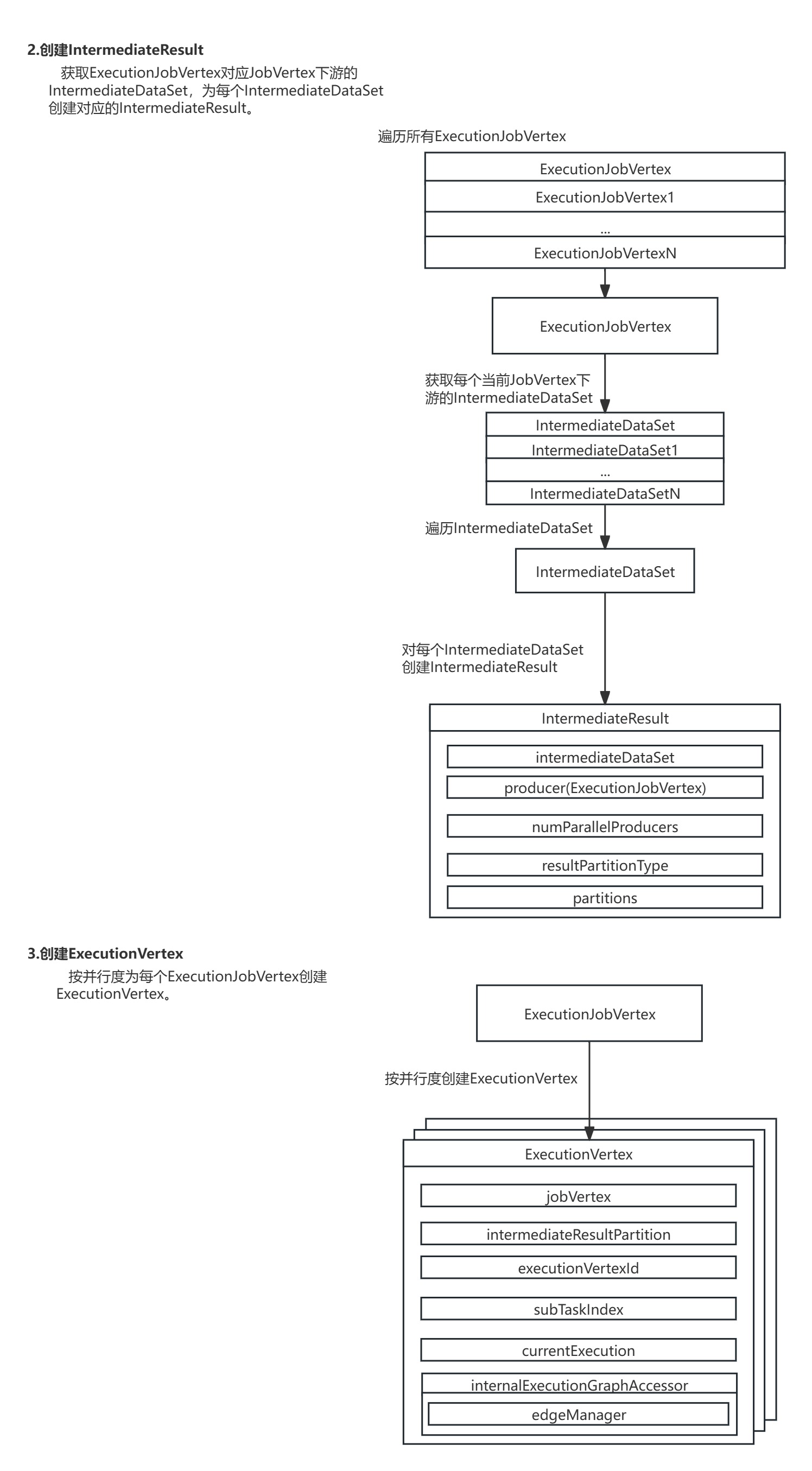
源码图解:
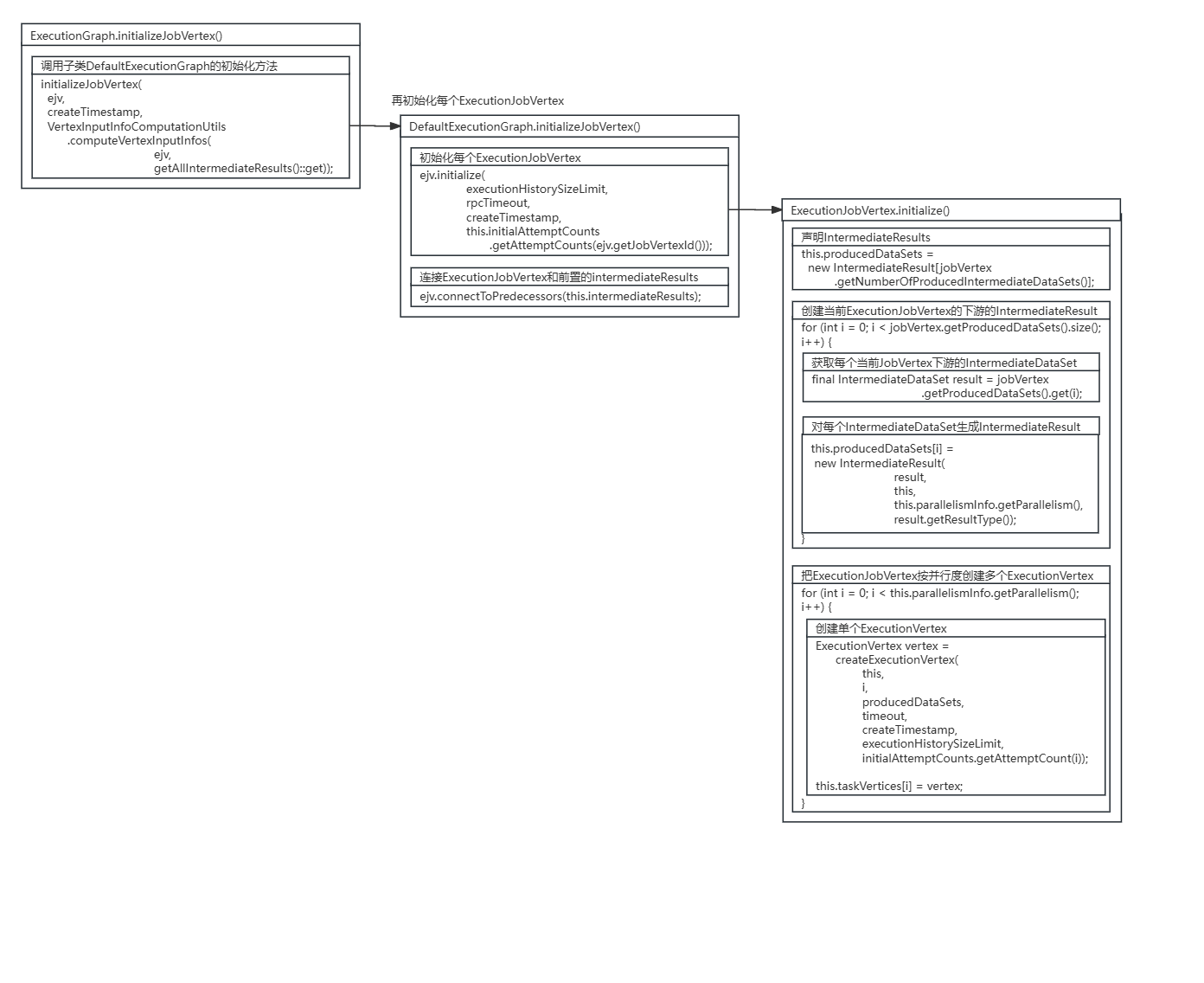
在ExecutionJobVertex的initialize()方法中,对ExecutionJobVertex节点每个下游IntermediateDataSet数据集生成对应的IntermediateResult数据集,并按并行度创建了每个ExecutionVertex。
ExecutionJobVertex.initialize()方法源码:
protected void initialize(int executionHistorySizeLimit,Time timeout,long createTimestamp,SubtaskAttemptNumberStore initialAttemptCounts)throws JobException {checkState(parallelismInfo.getParallelism() > 0);checkState(!isInitialized());this.taskVertices = new ExecutionVertex[parallelismInfo.getParallelism()];this.inputs = new ArrayList<>(jobVertex.getInputs().size());//声明IntermediateResults// create the intermediate resultsthis.producedDataSets =new IntermediateResult[jobVertex.getNumberOfProducedIntermediateDataSets()];//创建当前ExecutionJobVertex的下游的IntermediateResultfor (int i = 0; i < jobVertex.getProducedDataSets().size(); i++) {//获取每个当前JobVertex下游的IntermediateDataSetfinal IntermediateDataSet result = jobVertex.getProducedDataSets().get(i);//对每个IntermediateDataSet生成IntermediateResultthis.producedDataSets[i] =new IntermediateResult(result,this,this.parallelismInfo.getParallelism(),result.getResultType());}//把ExecutionJobVertex按并行度创建多个ExecutionVertex// create all task verticesfor (int i = 0; i < this.parallelismInfo.getParallelism(); i++) {//创建每个ExecutionVertexExecutionVertex vertex =createExecutionVertex(this,i,producedDataSets,timeout,createTimestamp,executionHistorySizeLimit,initialAttemptCounts.getAttemptCount(i));this.taskVertices[i] = vertex;}// sanity check for the double referencing between intermediate result partitions and// execution verticesfor (IntermediateResult ir : this.producedDataSets) {if (ir.getNumberOfAssignedPartitions() != this.parallelismInfo.getParallelism()) {throw new RuntimeException("The intermediate result's partitions were not correctly assigned.");}}// set up the input splits, if the vertex has anytry {@SuppressWarnings("unchecked")InputSplitSource<InputSplit> splitSource =(InputSplitSource<InputSplit>) jobVertex.getInputSplitSource();if (splitSource != null) {Thread currentThread = Thread.currentThread();ClassLoader oldContextClassLoader = currentThread.getContextClassLoader();currentThread.setContextClassLoader(graph.getUserClassLoader());try {inputSplits =splitSource.createInputSplits(this.parallelismInfo.getParallelism());if (inputSplits != null) {splitAssigner = splitSource.getInputSplitAssigner(inputSplits);}} finally {currentThread.setContextClassLoader(oldContextClassLoader);}} else {inputSplits = null;}} catch (Throwable t) {throw new JobException("Creating the input splits caused an error: " + t.getMessage(), t);}
}其中ExecutionVertex节点的创建是通过调用ExecutionJobVertex的createExecutionVertex()方法,进行了对ExecutionVertex节点的实例化。
ExecutionJobVertex.createExecutionVertex()方法源码:
protected ExecutionVertex createExecutionVertex(ExecutionJobVertex jobVertex,int subTaskIndex,IntermediateResult[] producedDataSets,Time timeout,long createTimestamp,int executionHistorySizeLimit,int initialAttemptCount) {//实例化每个ExecutionVertexreturn new ExecutionVertex(jobVertex,subTaskIndex,producedDataSets,timeout,createTimestamp,executionHistorySizeLimit,initialAttemptCount);
}6.创建每个ExecutionVertex节点对应的Execution与IntermediateResultPartition数据集分区
在ExecutionVertex的构造方法中,首先配置了ExecutionVertex节点的基本信息,然后根据下游IntermediateResult数据集的生成当前ExecutionVertex节点对应的IntermediateResultPartition数据集分区,最后创建封装Task执行信息的Execution。
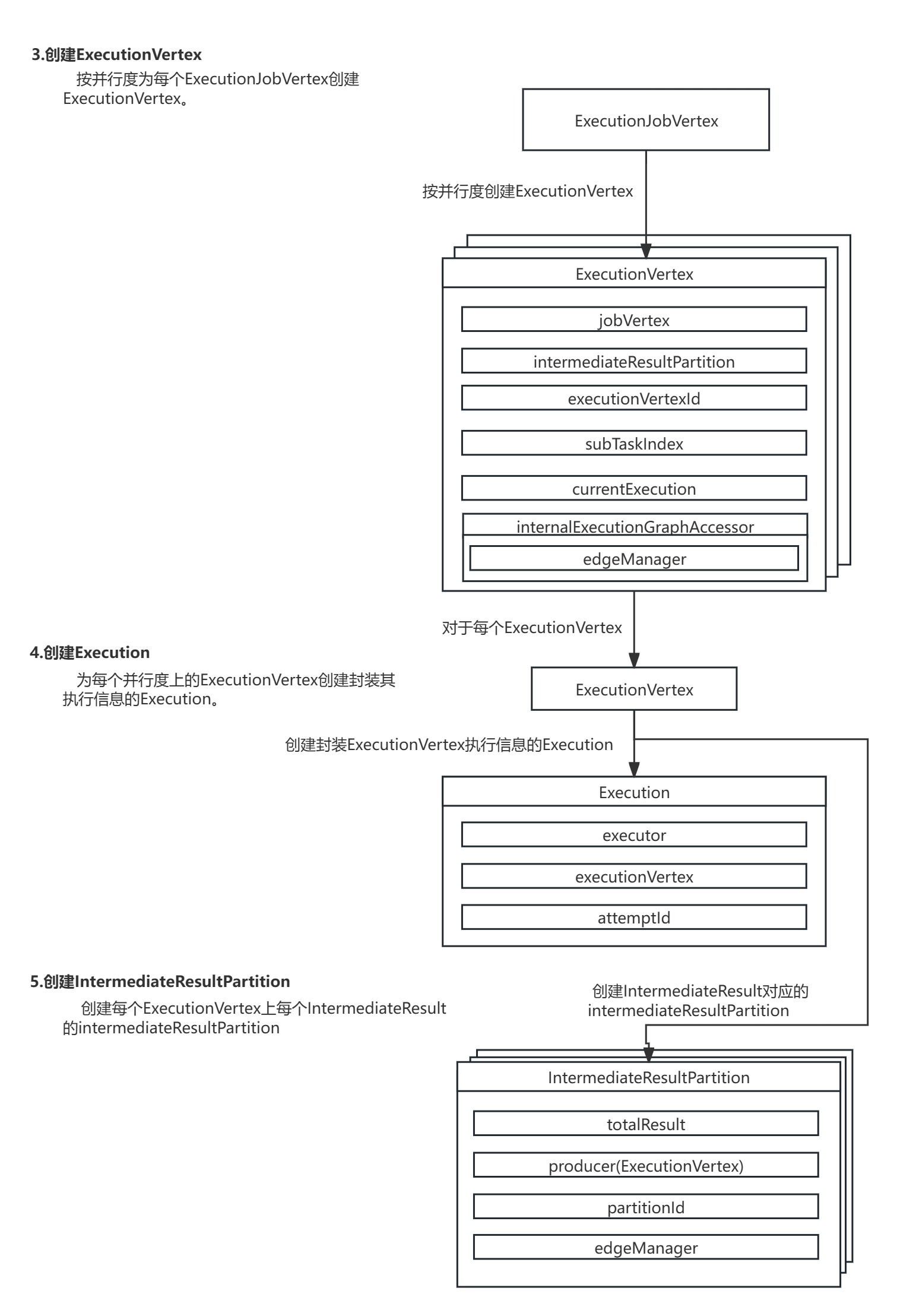
源码图解:
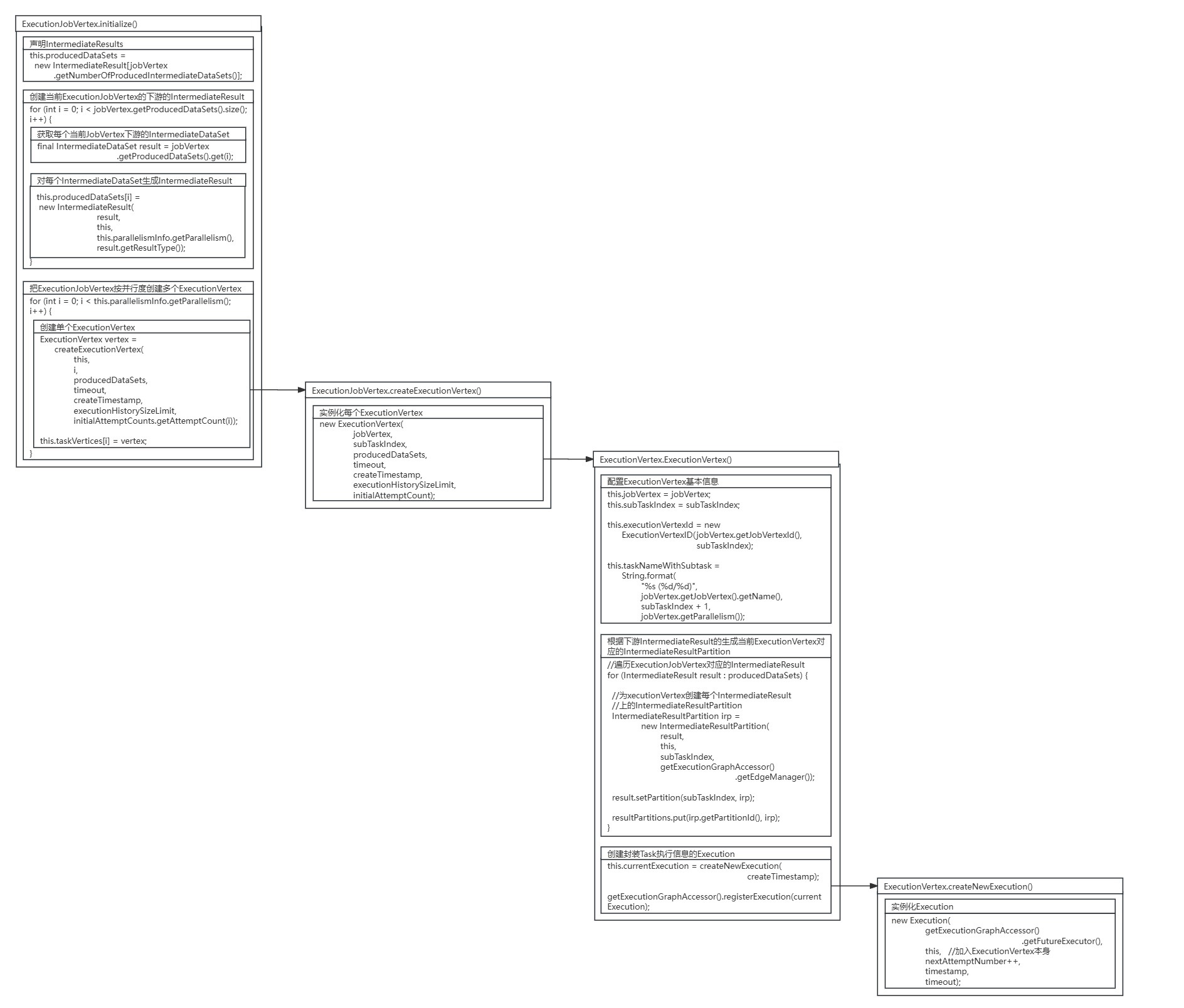
ExecutionVertex.ExecutionVertex()方法源码:
public ExecutionVertex(ExecutionJobVertex jobVertex,int subTaskIndex,IntermediateResult[] producedDataSets,Time timeout,long createTimestamp,int executionHistorySizeLimit,int initialAttemptCount) {//配置ExecutionVertex基本信息this.jobVertex = jobVertex;this.subTaskIndex = subTaskIndex;this.executionVertexId = new ExecutionVertexID(jobVertex.getJobVertexId(), subTaskIndex);this.taskNameWithSubtask =String.format("%s (%d/%d)",jobVertex.getJobVertex().getName(),subTaskIndex + 1,jobVertex.getParallelism());//根据下游IntermediateResult的生成当前ExecutionVertex对应的IntermediateResultPartitionthis.resultPartitions = new LinkedHashMap<>(producedDataSets.length, 1);for (IntermediateResult result : producedDataSets) {IntermediateResultPartition irp =new IntermediateResultPartition(result,this,subTaskIndex,getExecutionGraphAccessor().getEdgeManager());result.setPartition(subTaskIndex, irp);resultPartitions.put(irp.getPartitionId(), irp);
}this.executionHistory = new ExecutionHistory(executionHistorySizeLimit);this.nextAttemptNumber = initialAttemptCount;this.inputBytes = NUM_BYTES_UNKNOWN;this.timeout = timeout;this.inputSplits = new ArrayList<>();//创建封装Task执行信息的Executionthis.currentExecution = createNewExecution(createTimestamp);getExecutionGraphAccessor().registerExecution(currentExecution);
}在创建封装Task执行信息的Execution时,调用了ExecutionVertex.createNewExecution()方法进行了Execution的实例化。
ExecutionVertex.createNewExecution()方法源码:
Execution createNewExecution(final long timestamp) {//实例化Executionreturn new Execution(getExecutionGraphAccessor().getFutureExecutor(),this,nextAttemptNumber++,timestamp,timeout);
}7.结语
至此,ExecutionGraph的ExecutionJobVertex节点、ExecutionVertex节点、IntermediateResult数据集、IntermediateResultPartition数据集分区与封装Task执行信息的Execution都已创建完毕。因篇幅关系,ExecutionGraph生成的后续源码解析将继续在本专栏的下篇博文展开。
